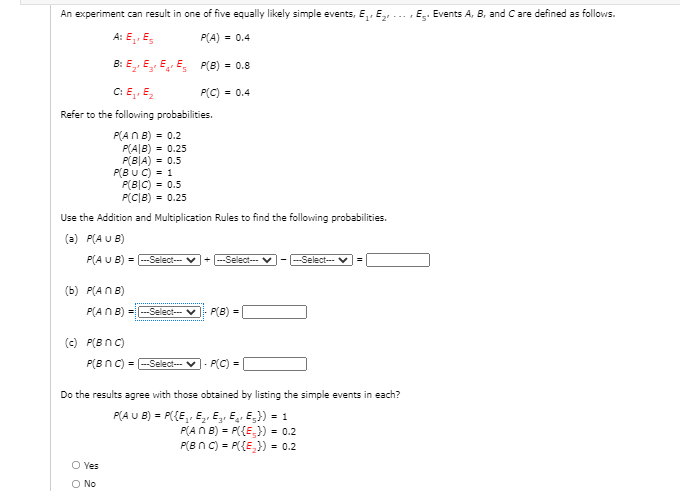An experiment can result in one of five equally likely simple events, E,, E, E. Events A, B, and Care defined as follows. A: E,, E, P(A) - 0.4 B: E, E,, E, E, P(B) = 0.8 C: E,, E, P(C) - 0.4 Refer to the following probabilities. P(AN B) - 0.2 P(A|B) - 0.25 P(B|A) = 0.5 P(B U C) - 1 P(B|C) - 0.5 P(C|B) - 0.25 Use the Addition and Multiplication Rules to find the following probabilities. (a) P(A U B) P(A U B) - -Select-- + -Select-- V- -Select-- V- (b) P(A N B) P(AN B) --Select--- V P(B) - (c) P(BnC) P(B n C) = -Selact- V) . P(C) = Do the results agree vwith those obtained by listing the simple events in each? P(A U B) = P({E,, E,, E,, E,, E,}) = 1 P(A N B) = P({E,}) = 0.2 P(B n C) = P({E,}) = 0.2 O Yes O No
An experiment can result in one of five equally likely simple events, E,, E, E. Events A, B, and Care defined as follows. A: E,, E, P(A) - 0.4 B: E, E,, E, E, P(B) = 0.8 C: E,, E, P(C) - 0.4 Refer to the following probabilities. P(AN B) - 0.2 P(A|B) - 0.25 P(B|A) = 0.5 P(B U C) - 1 P(B|C) - 0.5 P(C|B) - 0.25 Use the Addition and Multiplication Rules to find the following probabilities. (a) P(A U B) P(A U B) - -Select-- + -Select-- V- -Select-- V- (b) P(A N B) P(AN B) --Select--- V P(B) - (c) P(BnC) P(B n C) = -Selact- V) . P(C) = Do the results agree vwith those obtained by listing the simple events in each? P(A U B) = P({E,, E,, E,, E,, E,}) = 1 P(A N B) = P({E,}) = 0.2 P(B n C) = P({E,}) = 0.2 O Yes O No
Holt Mcdougal Larson Pre-algebra: Student Edition 2012
1st Edition
ISBN:9780547587776
Author:HOLT MCDOUGAL
Publisher:HOLT MCDOUGAL
Chapter11: Data Analysis And Probability
Section11.8: Probabilities Of Disjoint And Overlapping Events
Problem 2C
Related questions
Question
100%

Transcribed Image Text:An experiment can result in one of five equally likely simple events, E,, E,
E. Events A, B, and C are defined as follows.
A: E,, E,
P(A) = 0.4
B: E,, E E E, P(B) = 0.8
C: E,. E,
P(C) = 0.4
Refer to the following probabilities.
P(AN B) = 0.2
P(A|B) = 0.25
P(B|A) = 0.5
P(B U C) = 1
P(B|C) = 0.5
P(C|B) = 0.25
Use the Addition and Multiplication Rules to find the following probabilities.
(a) P(A U B)
P(A U B) = --Select-- v+ --Select--
---Select-- v
%3D
(b) P(ANB)
P(ANB) =-Select-- v
P(B) =
(c) P(B nC)
P(BnC) = -Select-- V- P(C) =
Do the results agree with those obtained by listing the simple events in each?
P(A U B) = P({E, E, E,, E, E;}) = 1
P(A N B) = P({E,}) = 0.2
P(Bn C) = P({E,}) = 0.2
O Yes
O No
Expert Solution
This question has been solved!
Explore an expertly crafted, step-by-step solution for a thorough understanding of key concepts.
This is a popular solution!
Trending now
This is a popular solution!
Step by step
Solved in 5 steps with 4 images

Recommended textbooks for you

Holt Mcdougal Larson Pre-algebra: Student Edition…
Algebra
ISBN:
9780547587776
Author:
HOLT MCDOUGAL
Publisher:
HOLT MCDOUGAL

College Algebra
Algebra
ISBN:
9781305115545
Author:
James Stewart, Lothar Redlin, Saleem Watson
Publisher:
Cengage Learning

Holt Mcdougal Larson Pre-algebra: Student Edition…
Algebra
ISBN:
9780547587776
Author:
HOLT MCDOUGAL
Publisher:
HOLT MCDOUGAL

College Algebra
Algebra
ISBN:
9781305115545
Author:
James Stewart, Lothar Redlin, Saleem Watson
Publisher:
Cengage Learning